Fatigue Damage Evaluation of Aviation Aluminum Alloy Based on Strain Monitoring
Abstract
:1. Introduction
2. Crystal Plasticity Modeling and Numerical Implementation
2.1. Theory of Crystal Plasticity
2.2. Definition of FIPs
2.3. Crystal Plasticity Finite Element Model of 7075-T6 Aluminum Alloy
3. Experimental Results and Analysis
3.1. Experiment Program
3.2. Analysis of Simulation and Test Results
4. Conclusions
Author Contributions
Funding
Institutional Review Board Statement
Informed Consent Statement
Data Availability Statement
Conflicts of Interest
References
- Stephens, R.I.; Fatemi, A.; Stephens, R.R.; Fuchs, H.O. Metal Fatigue in Engineering; John Wiley & Sons: New York, UK, 2001; pp. 3–7. [Google Scholar]
- Forrest, P.G. Fatigue of Metals; Pergamon Press: Oxford, UK, 1970; pp. 1–6. [Google Scholar]
- Dursun, T.; Soutis, C. Recent developments in advanced aircraft aluminium alloys. Mater. Des. 2014, 56, 862–871. [Google Scholar] [CrossRef]
- Li, S.S.; Yue, X.; Li, Q.Y.; Peng, H.L.; Dong, B.X.; Liu, T.S.; Yang, H.Y.; Fan, J.; Shu, S.L.; Qiu, F. Development and applications of aluminum alloys for aerospace industry. J. Mater. Res. Technol. 2023, 27, 944–983. [Google Scholar] [CrossRef]
- Mouritz, A.P. Aluminium alloys for aircraft structures. Introd. Aerosp. Mater. 2012, 1, 173–201. [Google Scholar]
- Ewing, J.A.; Humfrey, J., VI. The fracture of metals under repeated alternations of stress. Philos. Trans. R. Soc. London Ser. A Contain. Pap. Math. Phys. Character 1903, 200, 241–250. [Google Scholar]
- Coffin, L.F., Jr. A study of the effects of cyclic thermal stresses on a ductile metal. Trans. Am. Soc. Mech. Eng. 1954, 76, 931–949. [Google Scholar] [CrossRef]
- Manson, S. National Advisory Committee on Aerospace Technical Note 2933; National Advisory Committee: Cleveland, OH, USA, 1954.
- Laird, D.C.; Duquette, J. Corrosion Fatigue: Chemistry, Mechanics and Microstructure; National Association of Corrosion Engineers: Houston, TX, USA, 1972; pp. 88–117. [Google Scholar]
- Mughrabi, H. Cyclic slip irreversibilities and the evolution of fatigue damage. Metall. Mater. Trans. B 2009, 40, 431–453. [Google Scholar] [CrossRef]
- Yasbolaghi, R.; Khoei, A. Micro-structural aspects of fatigue crack propagation in atomistic-scale via the molecular dynamics analysis. Eng. Fract. Mech. 2020, 226, 106848. [Google Scholar] [CrossRef]
- Zhang, P.; Zhang, L.; Zhu, Q.; Chen, G.; Wang, C.; Fan, G.; Qin, H.; Tian, Q.; Gan, B. Evolution of fatigue mechanical properties and micro defects in nickel-based single crystal superalloys: A molecular dynamics research. Mater. Today Commun. 2023, 34, 105044. [Google Scholar] [CrossRef]
- Wu, W.; Chen, B.; Shen, H.; Ding, Z. Molecular dynamics simulation of rhenium effects on creep behavior of Ni-based single crystal superalloys. Prog. Nat. Sci. Mater. Int. 2022, 32, 259–266. [Google Scholar] [CrossRef]
- Sainath, G.; Rohith, P.; Choudhary, B. Fatigue deformation of polycrystalline Cu using molecular dynamics simulations. Trans. Indian Inst. Met. 2016, 69, 489–493. [Google Scholar] [CrossRef]
- Yang, Y.; Li, H.; Yang, Z.; Liu, J.; Kateye, E.K.; Zhao, J. Notch fatigue of Cu50Zr50 metallic glasses under cyclic loading: Molecular dynamics simulations. Commun. Theor. Phys. 2021, 73, 065501. [Google Scholar] [CrossRef]
- Zhang, J. Severe Plastic Deformation of Metal and Mesoscopic Constitutive Model Including Size Effect. Ph.D. Thesis, Guangxi University, Nanning, China, 2011. [Google Scholar]
- Shiraiwa, T.; Briffod, F.; Enoki, M. Prediction of Fatigue Crack Initiation of 7075 Aluminum Alloy by Crystal Plasticity Simulation. Materials 2023, 16, 1595. [Google Scholar] [CrossRef]
- Sun, T.; Qin, L.; Xie, Y.; Zheng, Z.; Xie, C.; Huang, Z. An Approach for Predicting the Low-Cycle-Fatigue Crack Initiation Life of Ultrafine-Grained Aluminum Alloy Considering Inhomogeneous Deformation and Microscale Multiaxial Strain. Materials 2022, 15, 3403. [Google Scholar] [CrossRef]
- Cen, C.-X.; Lu, D.-M.; Qin, D.-W.; Zhang, K.-S. Torsional Fatigue Life Prediction of 30CrMnSiNi2A Based on Meso-Inhomogeneous Deformation. Materials 2021, 14, 1846. [Google Scholar] [CrossRef] [PubMed]
- Jin, L.; Zeng, B.; Lu, D.; Gao, Y.; Zhang, K. Prediction of strain fatigue life of HRB400 steel based on meso-deformation inhomogeneity. Materials 2020, 13, 1464. [Google Scholar] [CrossRef]
- Sun, G.; Guo, Y.; Han, X.; Shang, D.; Chen, S. Fatigue modeling containing hardening particles and grain orientation for aluminum alloy FSW joints. Materials 2019, 12, 2024. [Google Scholar] [CrossRef] [PubMed]
- Jiang, J.; Dunne, F.P.; Britton, T.B. Toward predictive understanding of fatigue crack nucleation in Ni-based superalloys. Jom 2017, 69, 863–871. [Google Scholar] [CrossRef] [PubMed]
- Yuan, G.-J.; Zhang, X.-C.; Chen, B.; Tu, S.-T.; Zhang, C.-C. Low-cycle fatigue life prediction of a polycrystalline nickel-base superalloy using crystal plasticity modelling approach. J. Mater. Sci. Technol. 2020, 38, 28–38. [Google Scholar] [CrossRef]
- Pineau, A.; McDowell, D.L.; Busso, E.P.; Antolovich, S.D. Failure of metals II: Fatigue. Acta Mater. 2016, 107, 484–507. [Google Scholar] [CrossRef]
- Castelluccio, G.M.; McDowell, D.L. A mesoscale approach for growth of 3D microstructurally small fatigue cracks in polycrystals. Int. J. Damage Mech. 2014, 23, 791–818. [Google Scholar] [CrossRef]
- Dabiri, M.; Lindroos, M.; Andersson, T.; Afkhami, S.; Laukkanen, A.; Björk, T. Utilizing the theory of critical distances in conjunction with crystal plasticity for low-cycle notch fatigue analysis of S960 MC high-strength steel. Int. J. Fatigue 2018, 117, 257–273. [Google Scholar] [CrossRef]
- Abraham, S.T.; Babu, M.N.; Venkatraman, B. A novel ultrasonic non-destructive testing methodology to monitor fatigue crack growth in compact tension specimens. Rev. Sci. Instrum. 2023, 94, 035108. [Google Scholar] [CrossRef]
- Vié, T.; Deschanel, S.; Godin, N.; Normand, B. On the effect of coatings on the tensile and fatigue properties of 7075-T6 aluminum alloy monitored with acoustic Emission (AE): Towards lifetime estimation. Int. J. Fatigue 2023, 171, 107578. [Google Scholar] [CrossRef]
- Mohammad, I.; Huang, H. Monitoring fatigue crack growth and opening using antenna sensors. Smart Mater. Struct. 2010, 19, 055023. [Google Scholar] [CrossRef]
- Kumar, V.; Acot, B.; Aygun, L.E.; Wagner, S.; Verma, N.; Sturm, J.; Glisic, B. Detecting, localizing, and quantifying damage using two-dimensional sensing sheet: Lab test and field application. J. Civ. Struct. Health Monit. 2021, 11, 1055–1075. [Google Scholar] [CrossRef]
- Kong, X.; Li, J.; Collins, W.; Bennett, C.; Laflamme, S.; Jo, H. A large-area strain sensing technology for monitoring fatigue cracks in steel bridges. Smart Mater. Struct. 2017, 26, 085024. [Google Scholar] [CrossRef]
- Tikka, J.; Hedman, R.; Silijander, A. Strain gauge capabilities in crack detection. In Proceedings of the 4th International Workshop on Structural Health Monitoring, Stanford, CA, USA, 15–17 September 2003; pp. 15–17. [Google Scholar]
- Venkatachalam, S.; Murthy, H. Damage characterization and fatigue modeling of CFRP subjected to cyclic loading. Compos. Struct. 2018, 202, 1069–1077. [Google Scholar] [CrossRef]
- Fu, Q. Research on Online Fatigue Crack Monitoring and Life Prediction Based on Strain Analysis. Master’s Thesis, Xi’an University of Technology, Xi’an, China, 2018. [Google Scholar]
- Hill, R.; Rice, J. Constitutive analysis of elastic-plastic crystals at arbitrary strain. J. Mech. Phys. Solids 1972, 20, 401–413. [Google Scholar] [CrossRef]
- Asaro, R.J.; Rice, J. Strain localization in ductile single crystals. J. Mech. Phys. Solids 1977, 25, 309–338. [Google Scholar] [CrossRef]
- Peirce, D.; Asaro, R.J.; Needleman, A. Material rate dependence and localized deformation in crystalline solids. Acta Metall. 1983, 31, 1951–1976. [Google Scholar] [CrossRef]
- Needleman, A.; Asaro, R.; Lemonds, J.; Peirce, D. Finite element analysis of crystalline solids. Comput. Methods Appl. Mech. Eng. 1985, 52, 689–708. [Google Scholar] [CrossRef]
- Hutchinson, J.W. Bounds and self-consistent estimates for creep of polycrystalline materials. Proc. R. Soc. Lond. A Math. Phys. Sci. 1976, 348, 101–127. [Google Scholar]
- Huang, Y. A User-Material Subroutine Incroporating Single Crystal Plasticity in the ABAQUS Finite Element Program; Harvard University: Cambridge, UK, 1991. [Google Scholar]
- Frederick, C.O.; Armstrong, P. A mathematical representation of the multiaxial Bauschinger effect. Mater. High Temp. 2007, 24, 1–26. [Google Scholar] [CrossRef]
- Luo, J. Crystal Plasticity Based Polycrystalline Cyclic Constitutive Model and Its Finite Element Implementation. Master’s Thesis, Southwest Jiaotong University, Chengdu, China, 2014. [Google Scholar]
- Gu, T.; Stopka, K.S.; Xu, C.; McDowell, D.L. Prediction of maximum fatigue indicator parameters for duplex Ti–6Al–4V using extreme value theory. Acta Mater. 2020, 188, 504–516. [Google Scholar] [CrossRef]
- McDowell, D.; Dunne, F. Microstructure-sensitive computational modeling of fatigue crack formation. Int. J. Fatigue 2010, 32, 1521–1542. [Google Scholar] [CrossRef]
- Przybyla, C.P.; Musinski, W.D.; Castelluccio, G.M.; McDowell, D.L. Microstructure-sensitive HCF and VHCF simulations. Int. J. Fatigue 2013, 57, 9–27. [Google Scholar] [CrossRef]
- McDowell, D.L. Simulation-based strategies for microstructure-sensitive fatigue modeling. Mater. Sci. Eng. A 2007, 468, 4–14. [Google Scholar] [CrossRef]
- Manonukul, A.; Dunne, F. High–and low–cycle fatigue crack initiation using polycrystal plasticity. Proc. R. Soc. Lond. Ser. A Math. Phys. Eng. Sci. 2004, 460, 1881–1903. [Google Scholar] [CrossRef]
- Skelton, R. Cyclic hardening, softening, and crack growth during high temperature fatigue. Mater. Sci. Technol. 1993, 9, 1001–1008. [Google Scholar] [CrossRef]
- Barbe, F.; Decker, L.; Jeulin, D.; Cailletaud, G. Intergranular and intragranular behavior of polycrystalline aggregates. Part 1: FE model. Int. J. Plast. 2001, 17, 513–536. [Google Scholar] [CrossRef]
- Shankar, S.; Nithyaprakash, R.; Santhosh, B.; Uddin, M.; Pramanik, A. Finite element submodeling technique to analyze the contact pressure and wear of hard bearing couples in hip prosthesis. Comput. Methods Biomech. Biomed. Eng. 2020, 23, 422–431. [Google Scholar] [CrossRef]
- Lin, B.; Zhao, L.; Tong, J. A crystal plasticity study of cyclic constitutive behaviour, crack-tip deformation and crack-growth path for a polycrystalline nickel-based superalloy. Eng. Fract. Mech. 2011, 78, 2174–2192. [Google Scholar] [CrossRef]
- Sweeney, C.; O’Brien, B.; Dunne, F.; McHugh, P.; Leen, S. Strain-gradient modelling of grain size effects on fatigue of CoCr alloy. Acta Mater. 2014, 78, 341–353. [Google Scholar] [CrossRef]
- Sui, T.; Shi, D.; Yang, Q.; Fu, Q.; Gong, C.; Dong, C.; Yang, X. Material Parameter Identification Method of Crystal Plastic Constitutive Models. Propuls. Technol. 2023, 44, 210593. [Google Scholar]
- ASTM E1558-09; Standard Guide for Electrolytic Polishing of Metallographic Specimens. ASTM International: West Conshohocken, PA, USA, 2014.
- Nix, W.D.; Gao, H. Indentation size effects in crystalline materials: A law for strain gradient plasticity. J. Mech. Phys. Solids 1998, 46, 411–425. [Google Scholar] [CrossRef]
- Wang, Z.; Wu, S.; Kang, G.; Li, H.; Wu, Z.; Fu, Y.; Withers, P.J. In-situ synchrotron X-ray tomography investigation of damage mechanism of an extruded magnesium alloy in uniaxial low-cycle fatigue with ratchetting. Acta Mater. 2021, 211, 116881. [Google Scholar] [CrossRef]
- Moshtaghi, M.; Sato, S. Characterization of dislocation evolution in cyclically loaded austenitic and ferritic stainless steels via XRD line-profile analysis. ISIJ Int. 2019, 59, 1591–1598. [Google Scholar] [CrossRef]
- Moshtaghi, M.; Safyari, M. Effect of Work-Hardening Mechanisms in Asymmetrically Cyclic-Loaded Austenitic Stainless Steels on Low-Cycle and High-Cycle Fatigue Behavior. Steel Res. Int. 2021, 92, 2000242. [Google Scholar] [CrossRef]
- Liu, F.; Yan, Z.; He, X.; Wang, F.; Wang, Z.; Li, C.; Li, Y. Work-Harding/Softening Behavior and Temperature Evolution of AZ31B Magnesium Alloy During High Cycle Fatigue Process. Mech. Eng. Mater. 2018, 42, 27–30. [Google Scholar]
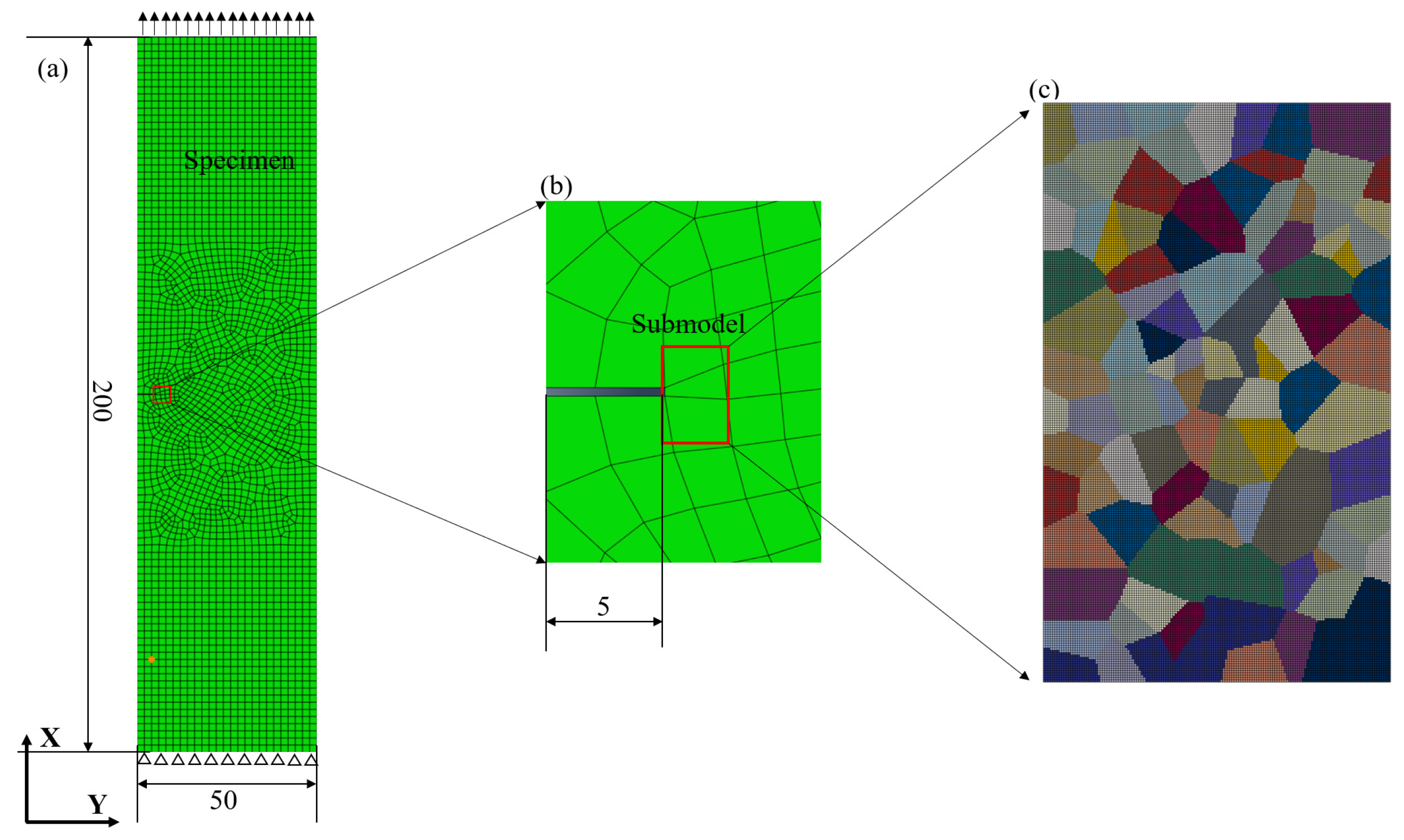
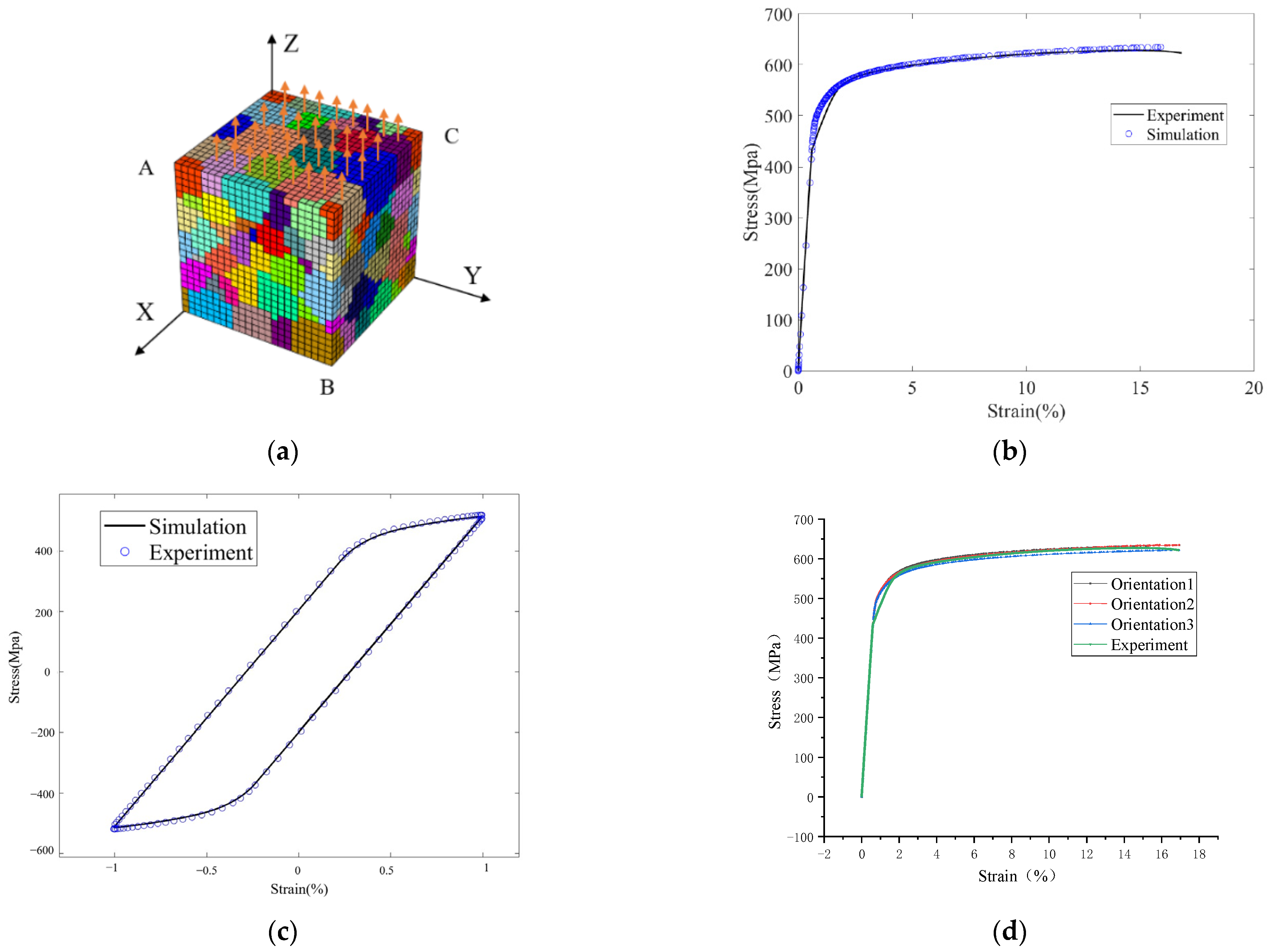
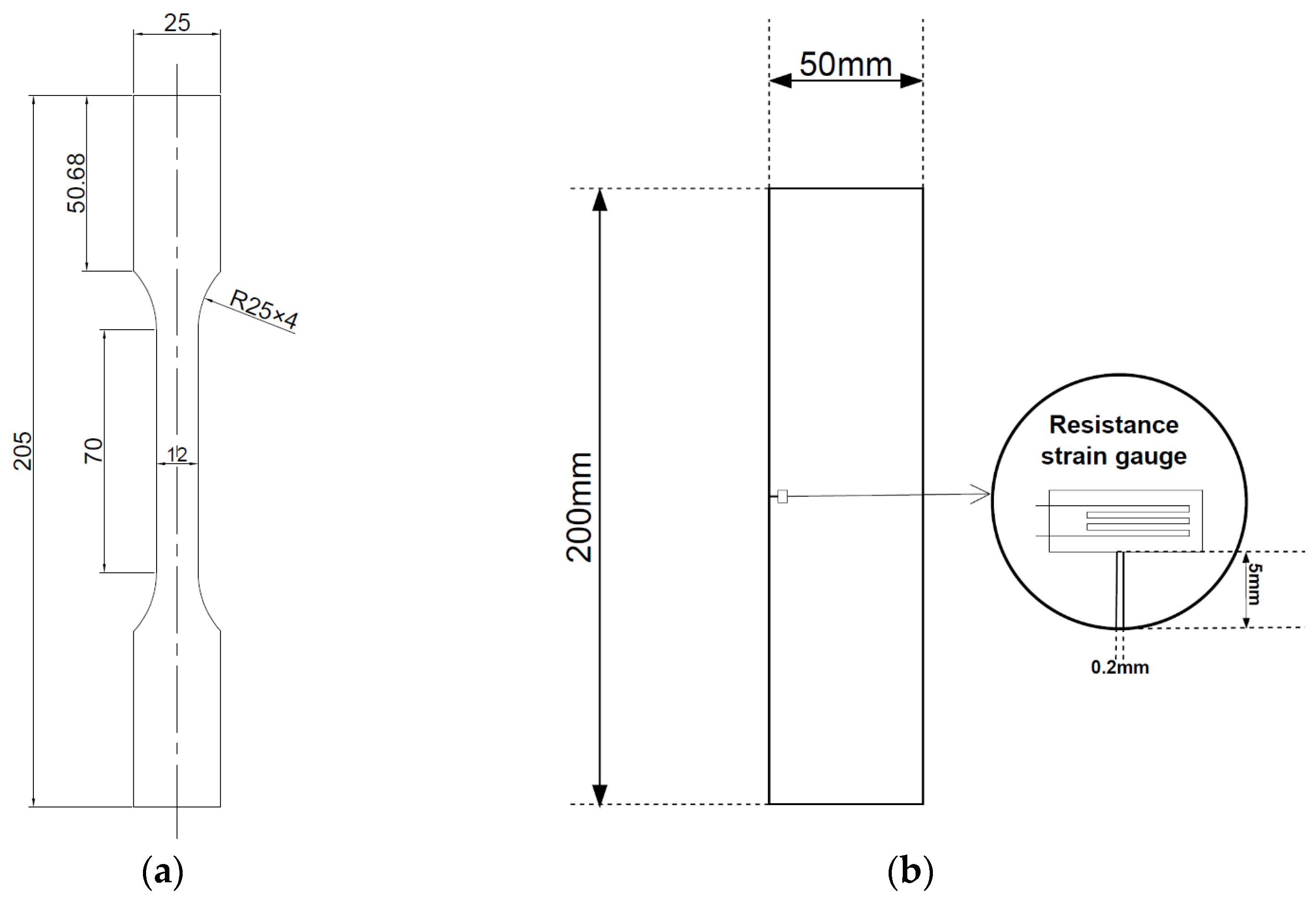
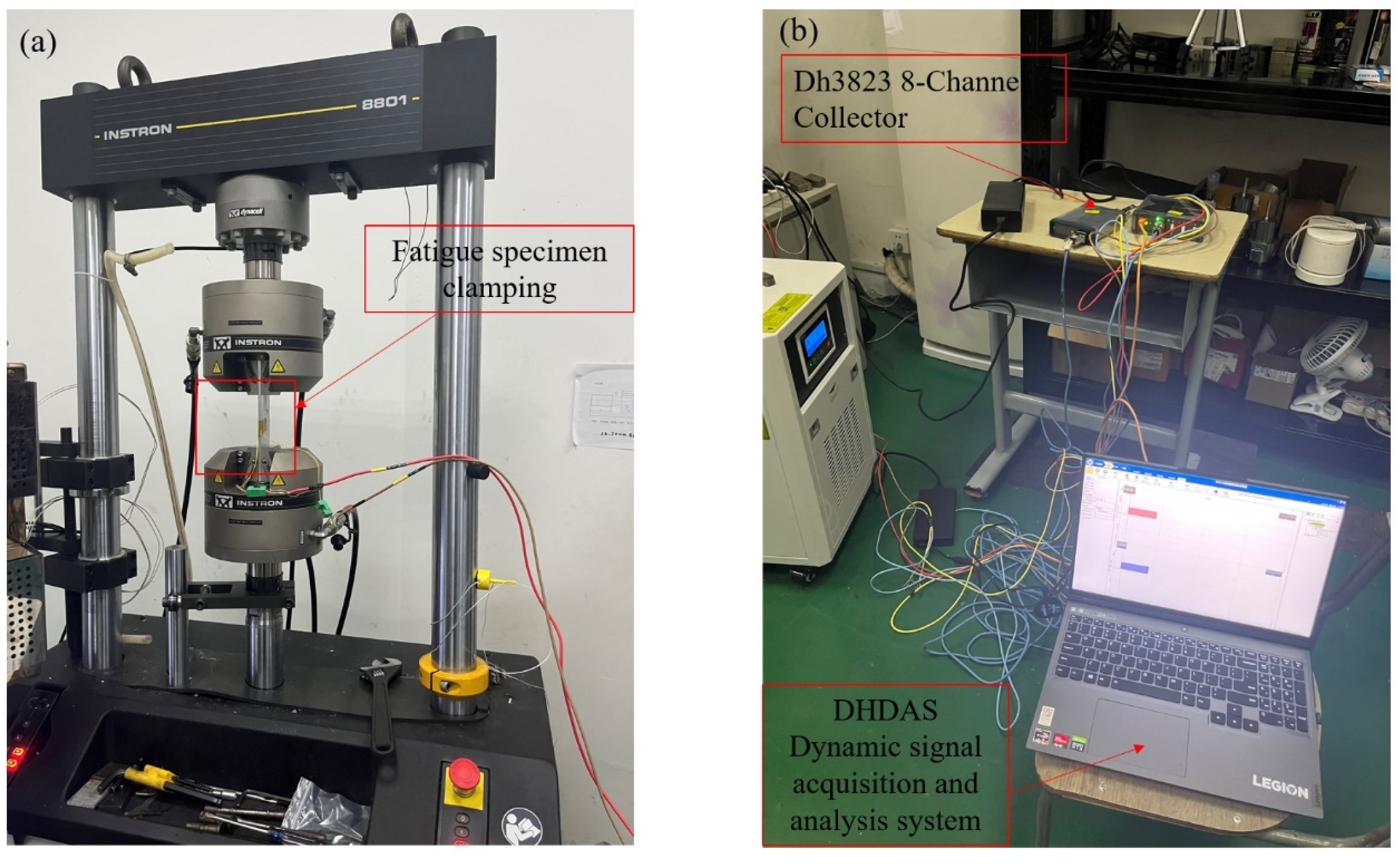
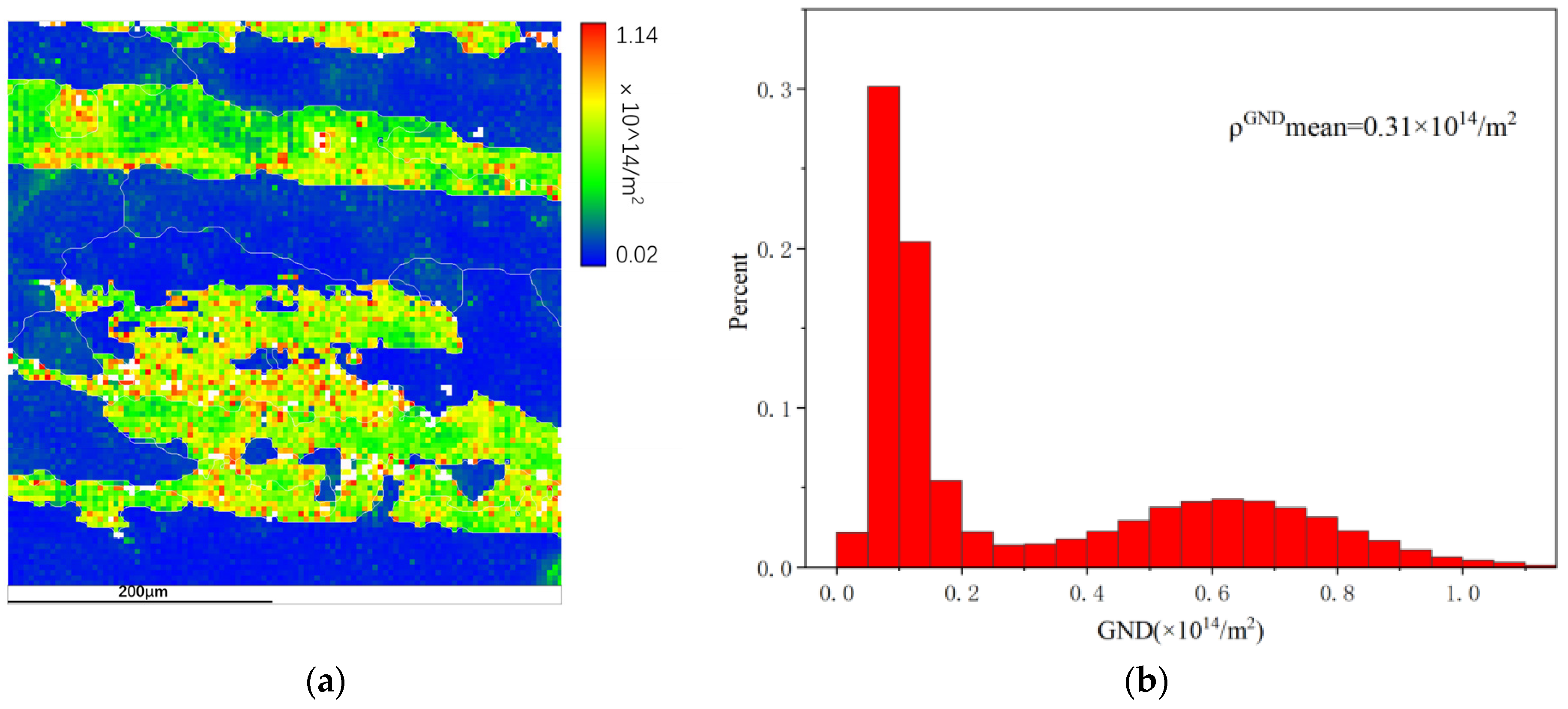
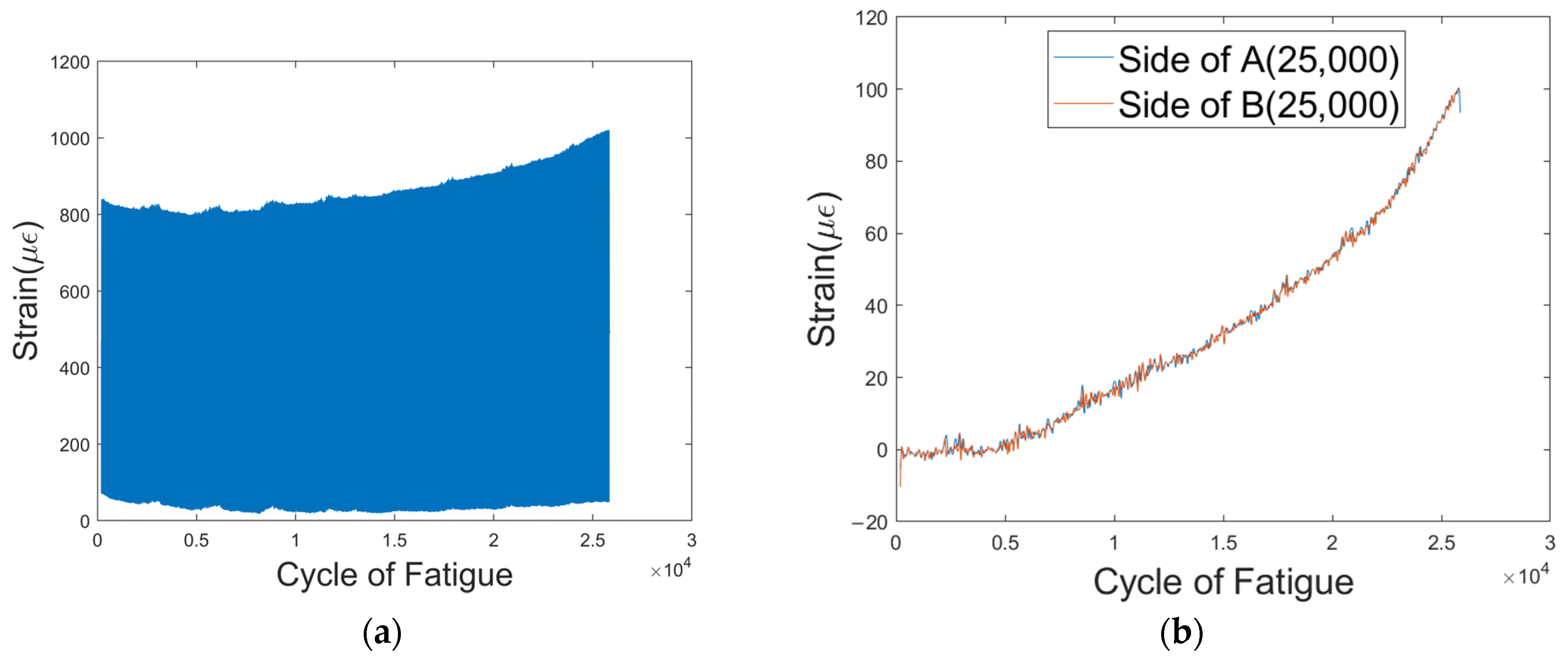
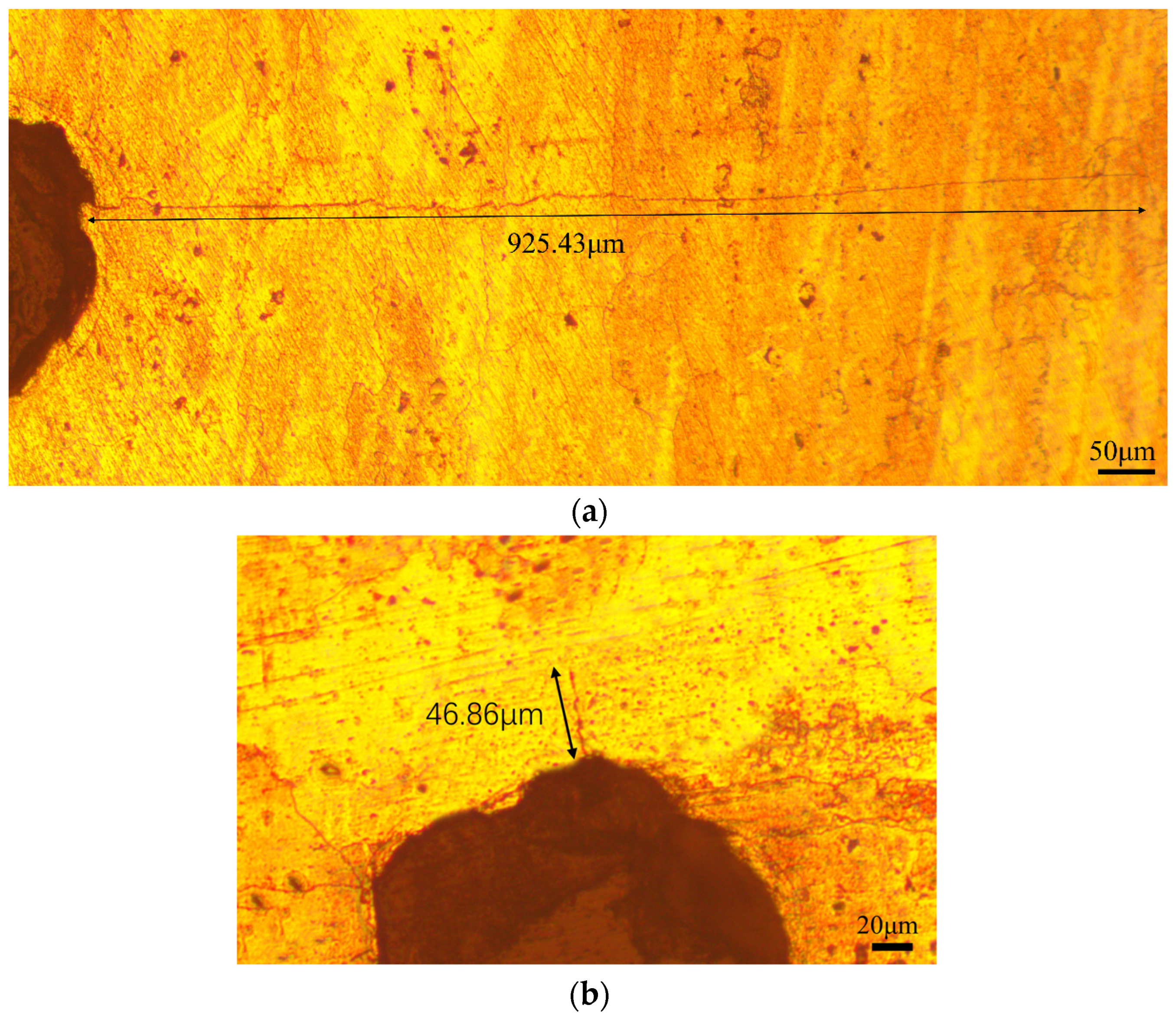
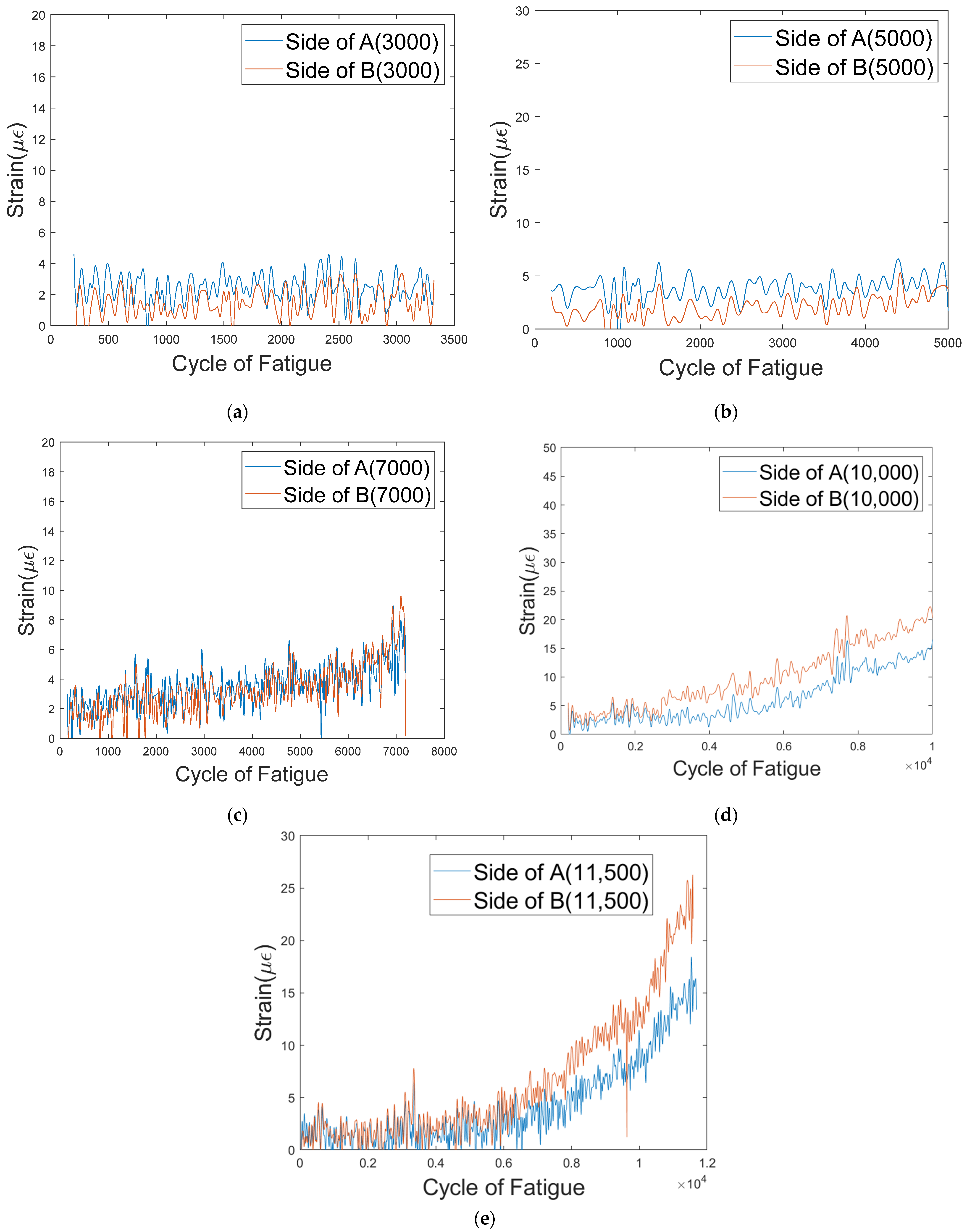
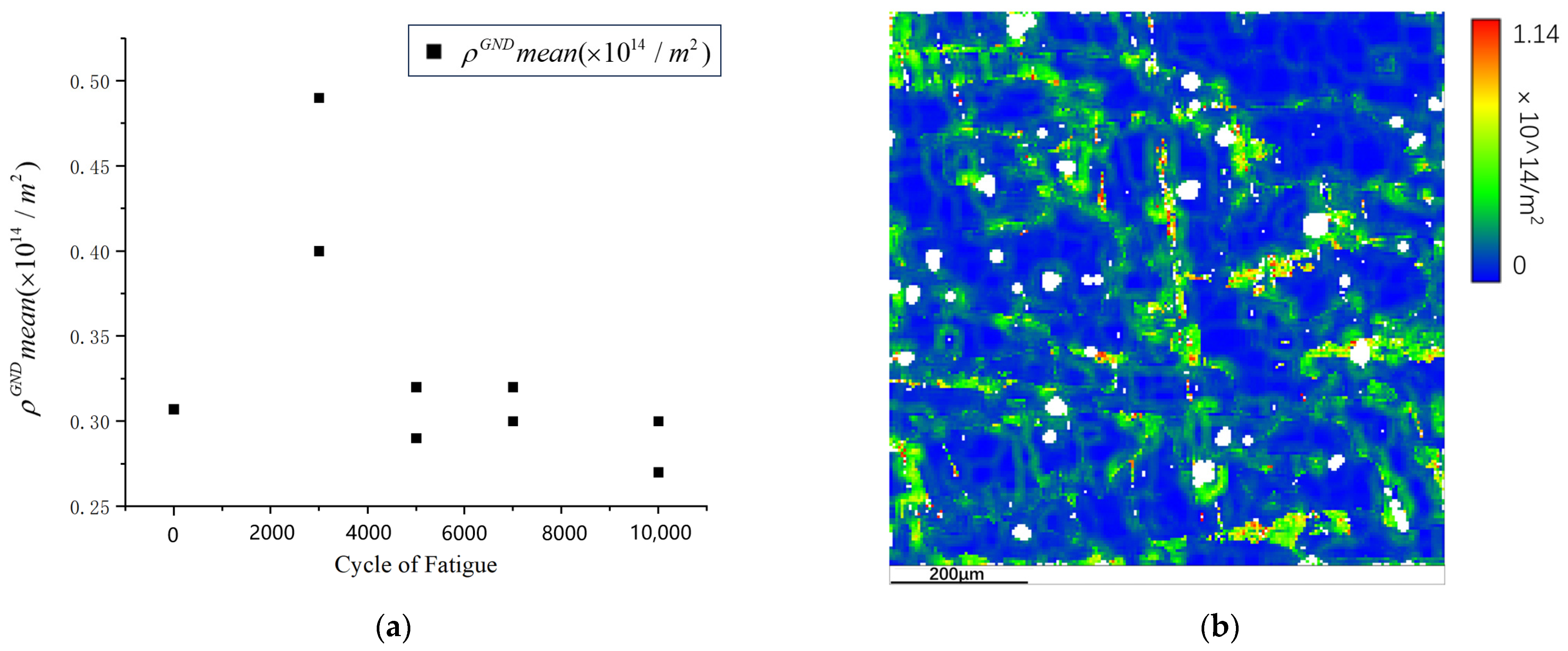


| (GPa) | (MPa) | (MPa) | ||||||
|---|---|---|---|---|---|---|---|---|
| 71.5 | 0.33 | 40 | 203 | 16 | 0.0 | 0.02 | 203 | 20 |
| Element | Si | Fe | Cu | Mn | Mg | Cr | Zn | Ti | Al |
|---|---|---|---|---|---|---|---|---|---|
| Atomic Content (%) | 0.16 | 0.37 | 1.7 | 0.19 | 2.8 | 0.22 | 5.9 | 0.03 | Bal. |
| Fatigue Parameters | |
|---|---|
| Loading Frequency/Hz | 5 |
| Strain Amplitude | 0.15% |
| Strain Ratio | 0.1 |
| Load Waveform | Simple Harmonic Vibration |
Disclaimer/Publisher’s Note: The statements, opinions and data contained in all publications are solely those of the individual author(s) and contributor(s) and not of MDPI and/or the editor(s). MDPI and/or the editor(s) disclaim responsibility for any injury to people or property resulting from any ideas, methods, instructions or products referred to in the content. |
© 2024 by the authors. Licensee MDPI, Basel, Switzerland. This article is an open access article distributed under the terms and conditions of the Creative Commons Attribution (CC BY) license (https://creativecommons.org/licenses/by/4.0/).
Share and Cite
Wu, J.; Wang, W.; Lu, M.; Hu, Y. Fatigue Damage Evaluation of Aviation Aluminum Alloy Based on Strain Monitoring. Appl. Sci. 2024, 14, 1184. https://doi.org/10.3390/app14031184
Wu J, Wang W, Lu M, Hu Y. Fatigue Damage Evaluation of Aviation Aluminum Alloy Based on Strain Monitoring. Applied Sciences. 2024; 14(3):1184. https://doi.org/10.3390/app14031184
Chicago/Turabian StyleWu, Jun, Wen Wang, Minghui Lu, and Yu Hu. 2024. "Fatigue Damage Evaluation of Aviation Aluminum Alloy Based on Strain Monitoring" Applied Sciences 14, no. 3: 1184. https://doi.org/10.3390/app14031184






